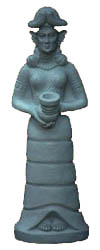
Home
Faith Index
Mother Goddess
The Modern Gaia Theory
Witchcraft
Occultism

Isjtar
Accadeic goddess, worshipped in Mesopatamia. One of the most important gates to Babylonia (Babel = Gate of the God) was the Isjtar gate. Her name means 'star' or 'womb'. She is a fighter, the goddess of war and of wisdom, destroyer of the land. She is an accadaic goddess, mostly known in Babylonia. She is also called 'Irninitum', meaning raging lion, as well as 'Iabattu' (Lyoness) and complainer.
 Isjtar is the wargoddess as the morning star 'Dilbah' and goddess of love as the evening star 'Zib' (=Venus). The Zodiak and the rainbow are here symbols. Her title is Erua, also known as Inanna. She chose the king for her sacred marriage and took care of babies being born.
Isjtar is the wargoddess as the morning star 'Dilbah' and goddess of love as the evening star 'Zib' (=Venus). The Zodiak and the rainbow are here symbols. Her title is Erua, also known as Inanna. She chose the king for her sacred marriage and took care of babies being born.
She is often mentioned as daughter of Anu, the god of the heavens. Her beloved dies and resurrects every year in the sheperd god Tammoetz or Adon Tammoetz, Adon meaning 'Lord'. The priestesses of Enheduanna, daughter of king Sargon, the founder of the city of Accad, made her equal to the Sumerian Inanna.
Her texts date back to 2,300 BCE, they are the oldest known texts with an autobiograhpichal character. Isjtar is the goddess of het fertile fields and herds, she is the mistress of the souverain land.
Her titles are 'Lady of Birth', 'Lady of the Bright Moon', 'Lady of the Morning and Evening Star', 'Goddess of Battle', 'Bringer of Justice and Law', 'Protector of the weak', 'Mother of fertile breasts', 'Happy Looking Lady of Passion and Desire'. She is also called Sharrat Shame (Queen of the Heavens). She is the goddess of war and blessing, compared with the Hindu goddess Durga. She is virgin and mother, goddess of love and sex.
Isjtar is identified as the star Sirius. On a Assyrian role dating back to 700 BCE she is pictured standing on a lion, with bow and arrow in her hands. She is surrounded by stars. The position of Sirius in conjuncion with the constellation of Lion in the monthe of July was the sign that the dry and hot season was coming. With her bow and arrow Inanna (Isjtar) destroyed the earth and the people. The month was named after Isjtars dead lover: Tammoetz.
To her the lions, dragons, griffins and the bull of heaven belong. She wore a eight pointed star on her shield. Her vulva is symbolized by objects made by lapis lazuli and gold. She wore the water, representing the rain she would send again after the dry season. As the planet Venus she represents a triade with the moon (Sin) and the sun (Sjamasj).
Isjtars' father is the god of heaven Anu. She was the patroness of Uruk, her anual marriage with the Lord of Uruk was meant to keep feritility safe. The ritual was held on newyears day with the following text: "My parts are well wetted lands. Who will drive the oxes?" Her story and that of Inanna are not completely similar. According to some versions the king is to be offered at the ending of his rule, just like in the story of Gilgamesj, who refuses to marry Isjtar.